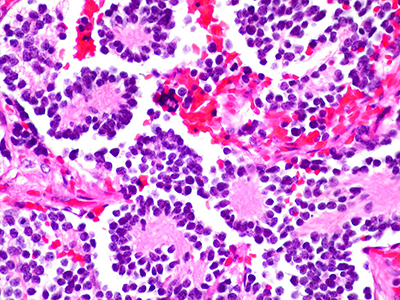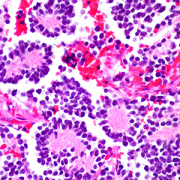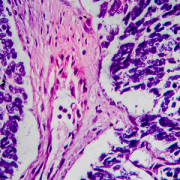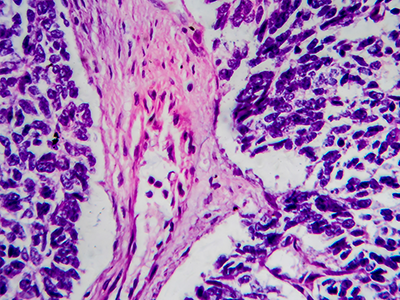Novel cancer vaccine targets oncogenes known to evade immunity in melanoma and neuroblastoma models

“Neuroblastoma of the Adrenal Gland (2)” by euthman is licensed under CC BY 2.0.
A personalized tumor cell vaccine strategy targeting Myc oncogenes combined with checkpoint therapy creates an effective immune response that bypasses antigen selection and immune privilege, according to a pre-clinical study for neuroblastoma and melanoma. The neuroblastoma model showed a 75% cure with long-term survival, researchers at Children’s National Hospital found.
Myc is a family of regulator genes and proto-oncogenes that help manage cell growth and differentiation in the body. When Myc mutates to an oncogene, it can promote cancer cell growth. The Myc oncogenes are deregulated in 70% of all human cancers.
Myc mutations, like the amplification of c-MYC and MYCN, are associated with host immune suppression in melanoma and neuroblastoma tumors, according to the study published in The Journal for Immunotherapy of Cancer.
“Paradoxically, from an immunotherapeutic perspective, a lack of an immune response may offer an opportunity to target those tumors [melanoma and neuroblastoma] that would be less resistant to host immunity assuming potent cellular immunity can be generated against the tumor,” said the authors.
The findings suggest that small molecule inhibitors — I-BET726 and JQ1 — suppress Myc’s uncontrolled cellular proliferation and enhance the immune response against tumor cells themselves, enabling their use as a tumor cell vaccine. The combination of cell vaccine and available therapies that keep the immune responses in check, also known as checkpoint inhibitor therapy, can help inform a personalized therapeutic tumor vaccine in the future.
“The work is pre-clinical and although we have seen excellent responses in these models, we need to determine whether this will also be effective in humans,” said Xiaofang Wu, staff scientist III at Sheikh Zayed Institute for Pediatric Surgical Innovation and lead author. “For this purpose we have started laboratory testing in human cells. Our eventual hope is to translate these basic science findings to clinical application.”
There is a need for more effective therapies for neuroblastoma and melanoma, given the poor outcome of patients experiencing high-risk or advanced disease through traditional chemotherapy methods. While the field has developed tumor vaccines and immune-based therapies, c-MYC and MYCN seem to protect the tumor against an immune response, so they often evade cure.
The researchers cautioned that both models induced potent immunity but draw different results, which means that this novel therapeutic vaccine is more effective in the neuroblastoma model than in the melanoma model. The neuroblastoma model resulted in a remarkable 75% cure and significantly improved long-term survival despite a larger initial tumor challenge.
“In contrast, the melanoma tumor gained adaptive resistance that is associated with an imbalance between tumor cell growth and cytotoxic killing and thus the vaccine failed to eradicate the tumor,” said the authors. “Despite potent immune effects from the vaccine, other immunosuppressive molecules will need to be targeted to see the full effects of the vaccine protocol in the melanoma model.”
The study proposes a framework that could be translated for therapeutic patient-specific vaccines for MYCN-amplified neuroblastoma tumors resistant to available therapies.
To understand the exact role of c-Myc and MYCN amplification and their association with immune suppression, the researchers examined 21 human neuroblastoma samples — the majority with metastatic disease — and 324 melanoma samples where only 30 were categorized as MYC amplified. Based on the oncogene’s capability to suppress the immune response, the researchers combined checkpoint inhibitors with pharmacologic molecules — I-BET726 and JQ1 — to target Myc oncogenes in mouse neuroblastoma and melanoma models. They also tested for the effects of different doses, drug combinations and incubation times on tumor cell proliferation, differentiation and gene alteration.
Authors on the study from Children’s National Hospital include: Xiaofang Wu, Ph.D., Marie Nelson, M.D., Mousumi Basu, Priya Srinivasan, Ph.D., Christopher Lazarski, Ph.D., and Anthony Sandler, M.D.





